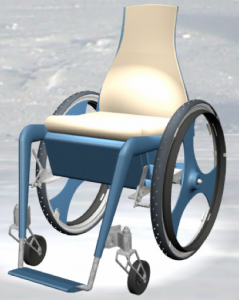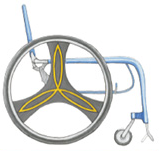PROJECT BRIEF
When: 2003-2004 (finalized)
What: To develop a safe mobility device that is easy to maneuver on varied terrains and in multiple weather conditions.The device should also improve user access to facilities and transportation, while being easily transportable.
Documentation:
- Project brief: PDF | 0.4 MB
- Project report: PDF | 4.8 MB
PROJECT SUMMARY
In this international project students worked on expanding today’s concept of mobility devices for active users. The primary goal was to address the challenges that people with disabilities face due to winter conditions.
Imagine yourself going up a steep grade in the dead of winter. There is a light dusting of snow and a thin layer of ice on the ground because it was warm the day before. You can barely keep yourself from falling let alone walk up the hill. That wing-flapping motion with your arms isn’t helping. Now imagine that same scenario but this time in a wheelchair that is meant for traversing linoleum floors. If you thought you were getting nowhere walking, try spinning around for a while!
The Task
CRE[ATIVO]2 is part of the Design for Wellbeing initiative, and its main goal is to enhance the wellbeing of persons with disabilities by using their description of needs as a starting point for product development.
The team started out with only one set of keywords to frame the scope of the project: active, winter, leisure time. From these words the team started to focus on mobility devices.Through rigorous needs analysis and benchmarking of current solutions the group discovered the need for winter-adaptable manual wheelchairs.Thus, the mission statement for the CRE[ATIVO]2 project was formulated:
To develop a safe mobility device that is easy to maneuver on varied terrains and in multiple weather conditions.The device should also improve user access to facilities and transportation, while being easily transportable.
International Cooperation
The work has been conducted in an iterative development process on a global scale. Eight students from Luleå University of Technology and four students from Stanford University, USA, have worked together as a single team, where each geographically separated group has contributed its own skills and viewpoints, both culturally and professionally, to solve the task. This, together with the fact that the two universities have different theories of approaching product development, has allowed the team to apply the best of both worlds during their work.All participants were also exposed to technologies supporting collaborative design, providing crucial experiences in multinational teamwork.
Results
Through numerous concept generations and evaluations, a light-weight composite wheelchair and a tire cleaning system was developed. By using composites instead of metal, the weight of the wheelchair was reduced, thus allowing for the addition of extra features while still keeping the chair lighter than the most popular chairs on the market today.
A center of gravity adjustment feature was added, whereby the user can adjust the center of gravity position while in the chair. This allowed for the backrest to be adjustable in different positions, giving the user added comfort.Traction in winter was improved by the addition of clip-ons with a unique tread pattern.
Finally, a wheel cleaning device was created to help the user to clean the chair before entering the house during late winter and early spring, when pavements are wet and dirty.
The team
The team was comprised of many different feilds of study. These fields vary from Education to Mechanical Engineering. This diverse knowledge base is what in theory will help to create a product that serves the needs of the user. With ideas and experience comming from all these different areas will prove to have the greatest impact in the project. There is also another group to add to this pool of knowledge, that being a group from Standford University.










